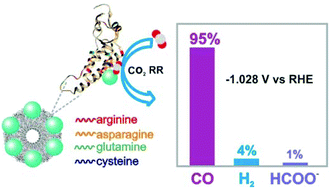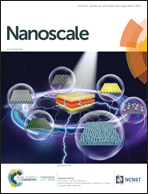Biosynthesized silver nanorings as a highly efficient and selective electrocatalysts for CO2 reduction†
Abstract
Inspiration from nature has driven the development and applications of greener inorganic nanomaterials prepared using biotemplates in the field of nanoscience. In this study, we report the superiority of using a biosynthesized silver nanoring material for CO formation in CO2 saturated KHCO3. Compared to bulk silver and free silver nanoparticles prepared by pure chemical reduction, this silver nanoring (assembled on tobacco mosaic virus coat protein) exhibits significantly enhanced activity and selectivity for the conversion of CO2 to CO. The highest CO faradaic efficiency reaches 95.0% at an overpotential of 910 mV. Additionally, the CO partial current density is 2.7-fold higher than that of the free silver nanoparticles. We believe that the improved catalytic performance is related to the structuring ligand effect of the protein. The numerous functional groups on the protein may tune the reaction activity by influencing the binding energies of the intermediate species from CO2 reduction or hydrogen evolution.



 Please wait while we load your content...
Please wait while we load your content...